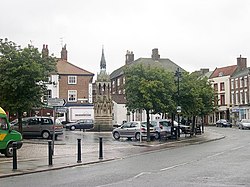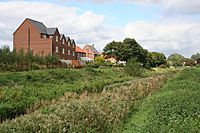Horncastle
| Horncastle | |
| Lincolnshire | |
|---|---|
 Horncastle Market Place | |
| Location | |
| Grid reference: | TF2669 |
| Location: | 53°12’29"N, 0°6’50"W |
| Data | |
| Population: | 6,651 (2010 est.) |
| Post town: | Horncastle |
| Postcode: | LN9 |
| Dialling code: | 01507 |
| Local Government | |
| Council: | East Lindsey |
| Parliamentary constituency: |
Louth and Horncastle |
Horncastle is a small market town in Lindsey, the northern part of Lincolnshire. It is 17 miles east, and 22 miles by road from the county town, the City of Lincoln. Horncastle’s population was estimated at 6,651 in 2010.
Contents
Geography
Holbeach lies to the south of the Lincolnshire Wolds, where the (north-south) River Bain meets the River Waring (from the east), and north of the West and Wildmore Fens.
The south of Horncastle is called Cagthorpe. Langton Hill is to the west.
Parish church
The parish church is St Mary's. It is a 13th-century church and a Grade II* listed building which was heavily restored between 1859 and 1861 by Ewan Christian.[1]
History
Roman
The Romans built a fort at Horncastle, which possibly became a Saxon Shore Fort.[2] Although fortified, Horncastle was not on any important Roman roads, which suggests that the River Bain was the principal route of access.
Roman Horncastle has become known as Banovallum (i.e. "Wall on the River Bain") – this name has been adopted by several local businesses and by the town's secondary modern school – but in fact the actual Roman name for the settlement is not definitely known:[2] Banovallum was suggested in the 19th century through an interpretation of the Ravenna Cosmography, a 7th-century list of Roman towns and road-stations;[3] Banovallum may in fact have been Caistor.
The walls of the Roman fort remain in places — one section is on display in the town's library, which is built over the top of the wall.[2] The ancestral English tribes called the town Hyrnecastre, whence arose its modern name.
Domesday Book
Horncastle is listed in the Domesday Book of 1086 as consisting of 41 households, including twenty-nine villagers and twelve smallholders, and had 100 acres of meadow and two mills, all belonging to The King.[4]
English Civil War
Four miles from Horncastle is the village of Winceby, where, during the Battle of Winceby in 1643 – which helped to secure Lincolnshire for Parliament – Cromwell was almost killed.[5] Local legend has it that the thirteen scythe blades which hang on the wall of the south chapel of the town's church, St Mary’s, were used as weapons at Winceby. This story is generally regarded as apocryphal, and the accepted opinion is that they probably date from the Lincolnshire Rising of 1536.[6][7]
Market and Horse Fair
Horncastle was given its market charter in the 13th century. It was formerly known for its great August Horse Fair — an internationally-famous annual trading event which lasted until the early 20th century. The town is now known as a centre for the antiques trade.[8]
The great annual horse fair probably first took place in the 13th century. The fair used to last for a week or more every August, and in the 19th century was probably the largest event of its kind in the United Kingdom. "Horncastle for horses" made the town famous – the fair was used as a setting for George Borrow's semi-autobiographical books Lavengro and The Romany Rye – but the last fair was held in 1948.[9]
In 1894 the Stanhope Memorial was erected in the centre of the Market Place in memory of Edward Stanhope MP by E. Lingen Barker. Built of limestone, red sandstone and pink and grey streaked marble, it is a Grade II listed structure.[10]
Sport
- Football: Horncastle Town FC
- Cricket
- Hockey
Floods
The town is susceptible to flooding,[11] notably in 1920 and 1960 – with 3 floods between 1981 and 1984.
Folklore belief associates the occurrence of floods with the changing of Horncastle's vicar. The vicar changed in 1919 and 1959, both less than a year before a flood. The flooding of the early 1980s was attributed to the change of vicar in 1980, however, there was no flooding in Horncastle following the change of vicar in 1999. Both the River Bain and River Waring burst their banks during the 2007 floods.[11][12][13]
Further flooding occurred in 2012.[14] A 30-year-old proposed flood defence scheme was seen as unlikely to have prevented the 2012 flood,[15] however, the installation of a new anti-flood pump was confirmed in 2013.[16]
On 7 October 1960 Horncastle entered the UK Weather Records with a 'Highest 180-min total' rainfall of 178 mm. As of March 2013, this record remains.[11][17] The water levels are said to have risen 8 feet as a consequence.[13]
Real-time river levels are available from The Environment Agency:
and flood warnings for the town:
- Watermill Road, Bridge Street, St. Lawrence Street, Prospect Street and West Street areas
- Stanhope Road, Banks Road, East Street, North Street, Wharf Road and Waring Street areas
Outside links
| ("Wikimedia Commons" has material about Horncastle) |
- A History of Horncastle (1908) by James Conway Walter
- Horncastle
- Horncastle Civic Society
- Horncastle Today - local news and sport website
- Horncastle Discovered
- Horncastle Family Name & Genealogy
- Queen Elizabeth's Grammar School
References
- ↑ National Heritage List 1168259: St Marys Church
- ↑ 2.0 2.1 2.2 National Monuments Record: No. 352692 – Bannovellum
- ↑ Roman-Britain.org
- ↑ "Horncastle". Open Domesday. Anna Powell-Smith/University of Hull. http://www.domesdaymap.co.uk/place/TF2569/horncastle/. Retrieved 23 October 2011.
- ↑ "Local web site, detailed account of civil war actions". http://www.horncastleuk.com/historydetail.php?id=1087&cid=1207&f=Horncastle. Retrieved 9 April 2011.
- ↑ "Local web site, account of rebellion (no mention of scythes)". http://www.horncastlediscovered.com/rebellion.htm.
- ↑ "Church History". http://lincoln.ourchurchweb.org.uk/horncastle/history/page1/. Retrieved 9 April 2011., discusses both theories about the scythes
- ↑ Wolds Horncastle
- ↑ "Local web site, Horse fair details". http://www.horncastlediscovered.com/horse-fair.htm.
- ↑ National Heritage List 1262721: Stanhope Memorial
- ↑ 11.0 11.1 11.2 David N Robinson. "Horncastle and the Problem of Floods". The Old Chapel, Church Close, Boston, Lincolnshire PE21 6NP: Visitor UK Ltd. http://www.visitoruk.com/Horncastle/problem-of-floods-C1207-HL1090.html. Retrieved 22 Feb 2013.
- ↑ "Visiting Horncastle". Lincolnshire Tourist Guide Ltd. http://www.lincolnshiretouristguide.com/Visiting-Horncastle.asp. Retrieved 22 Mar 2013.Mentions both the rainfall record and the folklore link of floods with installations of Vicars
- ↑ 13.0 13.1 "Floods make national news". Horncastle News. 12/08/2012 12:46. http://www.horncastlenews.co.uk/community/nostalgia/floods-make-national-news-1-4146906. Retrieved Friday 22 March 2013.
- ↑ "Lincolnshire clean-up operation after flash floods". News Lincolnshire (BBC). 29 June 2012 10:10. http://www.bbc.co.uk/news/uk-england-lincolnshire-18637844. Retrieved 22 March 2013.
- ↑ "£15m defence scheme will not stop town homes flooding". Horncastle News. 14 July 2012. http://www.horncastlenews.co.uk/news/environment/15m-defence-scheme-will-not-stop-town-homes-flooding-1-4046764. Retrieved Friday 22 March 2013.
- ↑ "Major boost to Horncastle flood defences". Horncastle News. 3 March 2013. http://www.horncastlenews.co.uk/news/local/major-boost-to-horncastle-flood-defences-1-4892604. Retrieved Friday 22 March 2013.
- ↑ "Extremes: UK rainfall records for short durations". Met Office. http://www.metoffice.gov.uk/climate/uk/extremes/. Retrieved 22 March 2013.Highest 180-minute total 178 mm 7 October 1960 Horncastle (Lincolnshire)




